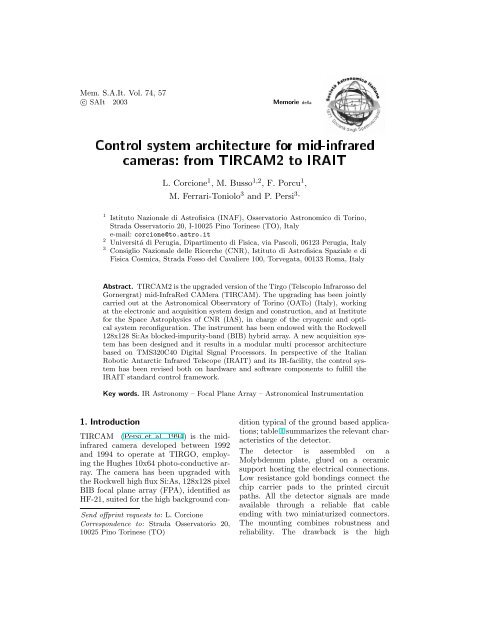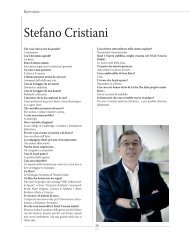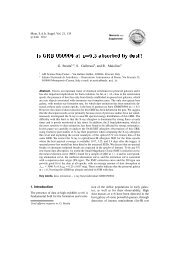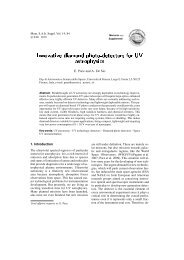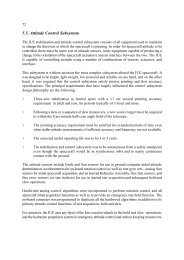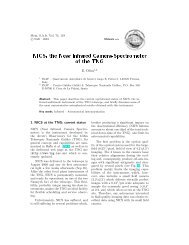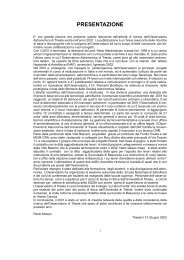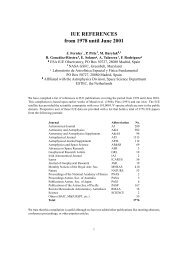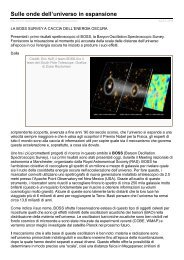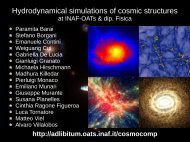Control system architecture for mid-infrared cameras: from TIRCAM2 ...
Control system architecture for mid-infrared cameras: from TIRCAM2 ...
Control system architecture for mid-infrared cameras: from TIRCAM2 ...
You also want an ePaper? Increase the reach of your titles
YUMPU automatically turns print PDFs into web optimized ePapers that Google loves.
Mem. S.A.It. Vol. 74, 57<br />
c○ SAIt 2003 Memorie della<br />
<strong>Control</strong> <strong>system</strong> <strong>architecture</strong> <strong>for</strong> <strong>mid</strong>-<strong>infrared</strong><br />
<strong>cameras</strong>: <strong>from</strong> <strong>TIRCAM2</strong> to IRAIT<br />
L. Corcione 1 , M. Busso 1,2 , F. Porcu 1 ,<br />
M. Ferrari-Toniolo 3 and P. Persi 3,<br />
1 Istituto Nazionale di Astrofisica (INAF), Osservatorio Astronomico di Torino,<br />
Strada Osservatorio 20, I-10025 Pino Torinese (TO), Italy<br />
e-mail: corcione@to.astro.it<br />
2 Universitá di Perugia, Dipartimento di Fisica, via Pascoli, 06123 Perugia, Italy<br />
3 Consiglio Nazionale delle Ricerche (CNR), Istituto di Astrofisica Spaziale e di<br />
Fisica Cosmica, Strada Fosso del Cavaliere 100, Torvegata, 00133 Roma, Italy<br />
Abstract. <strong>TIRCAM2</strong> is the upgraded version of the Tirgo (Telscopio Infrarosso del<br />
Gornergrat) <strong>mid</strong>-InfraRed CAMera (TIRCAM). The upgrading has been jointly<br />
carried out at the Astronomical Observatory of Torino (OATo) (Italy), working<br />
at the electronic and acquisition <strong>system</strong> design and construction, and at Institute<br />
<strong>for</strong> the Space Astrophysics of CNR (IAS), in charge of the cryogenic and optical<br />
<strong>system</strong> reconfiguration. The instrument has been endowed with the Rockwell<br />
128x128 Si:As blocked-impurity-band (BIB) hybrid array. A new acquisition <strong>system</strong><br />
has been designed and it results in a modular multi processor <strong>architecture</strong><br />
based on TMS320C40 Digital Signal Processors. In perspective of the Italian<br />
Robotic Antarctic Infrared Telscope (IRAIT) and its IR-facility, the control <strong>system</strong><br />
has been revised both on hardware and software components to fulfill the<br />
IRAIT standard control framework.<br />
Key words. IR Astronomy – Focal Plane Array – Astronomical Instrumentation<br />
1. Introduction<br />
TIRCAM (Persi et al. 1994) is the <strong>mid</strong><strong>infrared</strong><br />
camera developed between 1992<br />
and 1994 to operate at TIRGO, employing<br />
the Hughes 10x64 photo-conductive array.<br />
The camera has been upgraded with<br />
the Rockwell high flux Si:As, 128x128 pixel<br />
BIB focal plane array (FPA), identified as<br />
HF-21, suited <strong>for</strong> the high background con-<br />
Send offprint requests to: L. Corcione<br />
Correspondence to: Strada Osservatorio 20,<br />
10025 Pino Torinese (TO)<br />
dition typical of the ground based applications;<br />
table 1 summarizes the relevant characteristics<br />
of the detector.<br />
The detector is assembled on a<br />
Molybdenum plate, glued on a ceramic<br />
support hosting the electrical connections.<br />
Low resistance gold bondings connect the<br />
chip carrier pads to the printed circuit<br />
paths. All the detector signals are made<br />
available through a reliable flat cable<br />
ending with two miniaturized connectors.<br />
The mounting combines robustness and<br />
reliability. The drawback is the high
58 L. Corcione et al.: <strong>TIRCAM2</strong><br />
thermal inertia of the mounting, that in<br />
turn implies long time <strong>for</strong> reaching 5 o K<br />
thermal equilibrium and slight thermal<br />
instability during operations.<br />
To correctly operate the new detector and<br />
provide all the operating modes useful <strong>for</strong><br />
IR ground based observations, an innovative<br />
controller has been devised; section 2<br />
describes the hardware and the software of<br />
the control <strong>system</strong>.<br />
In order to use the extended sensitivity<br />
up to 28 µm of the Rockwell detector, as<br />
well as to match the pixel size, a new optical<br />
<strong>system</strong>, based on a purely reflecting<br />
components, is under development at IAS<br />
laboratory.<br />
The camera currently uses the optics of<br />
the previous configuration, which includes<br />
lenses, baffles, filters, heater and temperature<br />
sensors on the 8-inch oxygen-free copper<br />
base plate of the dewar. The optical<br />
scheme consists of relay optics made of two<br />
ZnSe lenses and a Lyot stop, and was designed<br />
<strong>for</strong> the 1.5m diameter, f/20 TIRGO<br />
telescope. It produces a magnification of<br />
1.49 and a plate scale of 10.25 arcsec/mm,<br />
i.e. 0.84 arcsec/pixel on the Rockwell array<br />
with the Airy pattern covering 4x4 pixels<br />
at 10 µm. The exit pupil at the focal plane<br />
has a diameter of 7.68 mm, less than the<br />
total area of the detetector (9.6x9.6 mm).<br />
This produces a vignetting of about 10 pixels<br />
at detector edges. Such a limitation, acceptable<br />
<strong>for</strong> the preliminary set-up of the<br />
instrument, will be removed by the new reflecting<br />
optics. The filter <strong>system</strong> is made<br />
of five OCLI (Optical Coating Laboratories<br />
Industries) filters, 10% bandwidth, with effective<br />
wavelengths at 8.8, 9.8, 10.3, 11.7<br />
and 12.5 µm, and a circular variable filter<br />
(CVF) covering the range 8-14 µm with 3%<br />
resolution. They are assembled in a circular<br />
filter wheel controlled by a step motor.<br />
Optics, filter wheel and detector are accommodated<br />
inside a 2.8 liter liquid-He<br />
cooled cryostat fabricated by Infrared Lab,<br />
Tucson(Arizona); by a fine tuning of the<br />
thermal contact between the dewar plate<br />
and the array carrier, the working temperature<br />
of the detectors is fixed to 5 o K.<br />
We <strong>for</strong>esee to endow the equipment with a<br />
modern closed cycle cooler.<br />
Although the camera has been refurbished<br />
to operate at a conventional telescope<br />
as TIRGO, some features meet the<br />
requirements <strong>for</strong> a similar observing facility<br />
planned <strong>for</strong> IRAIT. At some extend,<br />
TIRCAM upgrading has also been<br />
carried out to check scientific and technical<br />
operating modes to be implemented<br />
on the IRAIT camera: the Rockwell detector<br />
and the optimized incoming optics<br />
offer the opportunity to exploit the atmospheric<br />
windows beyond the 20µm, accessible<br />
on the Antarctic plateau; closed cycle<br />
cooler based dewar and remote controlled<br />
electronics are, at least partially, compliant<br />
to remotely and robotic operated equipment<br />
as required by the Antarctic environment.<br />
The experience acquired in building<br />
and operating TIRCAM and <strong>TIRCAM2</strong><br />
has been used to design the electronics <strong>for</strong><br />
the IRAIT camera whose control <strong>system</strong> is<br />
described in some detail in section 3.<br />
2. TIRCAM <strong>Control</strong> System<br />
The control and read-out requirements <strong>for</strong><br />
thermal IR arrays are <strong>for</strong> aggregate data<br />
rates up to several Megapixel per second<br />
<strong>from</strong> large number of channels, even <strong>for</strong> detectors<br />
not so large as the ones used in visible<br />
wavelength (CCD) and IR array <strong>for</strong> the<br />
near IR regime below 2.5 µm.<br />
High background environment produces so<br />
much flux that thermal IR array saturates<br />
on a time scale of few milliseconds. Still,<br />
the sky background fluctuates at rate of few<br />
hertz and overcomes the signal <strong>from</strong> stars;<br />
in such a condition, the detection of scientific<br />
target is possible only sampling alternatively<br />
sky and source signal, i.e. by chopping<br />
technique, which increases the number<br />
of data throughput.<br />
Handling a modern astronomical focal<br />
plane array, sensitive at wavelength longer<br />
than 5 µm, providing large well capacity<br />
and large number of readout channels, requires<br />
a control <strong>system</strong> featuring high per<strong>for</strong>mance<br />
in terms of read-out speed, dy-
Table 1. Rockwell Array features<br />
L. Corcione et al.: <strong>TIRCAM2</strong> 59<br />
Rockwell 128x128 pixels Si:As BIB Focal Plane Array<br />
Pixel Pitch 75µm<br />
Spectral Response 2-28 µm<br />
Q.E. 0.7<br />
Well Capacity<br />
2.10 8 e −<br />
n. outputs 16<br />
Frame rate<br />
< 4000/sec<br />
Readout Noise ∼ 1300<br />
Output Signal<br />
2.5 Volt<br />
Readout Mode<br />
Destructive<br />
Sampling Technique<br />
Single read<br />
Table 2. <strong>TIRCAM2</strong> Acquisition <strong>system</strong> per<strong>for</strong>mances<br />
System<br />
Detector<br />
Timing by 16 bit counters:<br />
Read Time allowed:<br />
Frame time > 360µm Frame rate < 4000/s<br />
Pixel Time Resolution 160ns Single Output rate < 4x10 6 px/s<br />
Frame co-adding capacity < 128000<br />
System Transfer Gain:<br />
Readout Noise:<br />
153 µV/ADU @ zilch flux 172 µV<br />
1485 e − /ADU (1720 e − )<br />
A/D toggle noise:<br />
0.7 ADU<br />
Preamp input referred noise: 110 µV @ 4x10 14 ph/s/cm 2 330 µV<br />
(1050 e − ) (3300 e − )<br />
namic range and real time data processing<br />
capabilities.<br />
The <strong>TIRCAM2</strong> controller is designed to<br />
satisfy all these requirements, and, though<br />
it is tailored <strong>for</strong> the detector in use, its modular<br />
<strong>architecture</strong>, both hardware and software,<br />
can be easily upgraded to different<br />
applications.<br />
The controller is split in two blocks and employs<br />
commercial components and custom<br />
parts. The first block consists of a custom<br />
circuit with 16 low noise, high bandwidth<br />
pre-amplifying channels, matching the detector<br />
video signals to the dynamic range<br />
of the Analog-Digital(AD) converters. The<br />
industrial PC rack houses the acquisition<br />
cards and the custom bias-clock generator<br />
in the ISA bus branch of the back-plane.<br />
CPU board, the video interface and the<br />
Ethernet card are allocated on the PCI bus.<br />
Both units, when the camera is installed at<br />
the telescope, are located very close to the<br />
dewar; a box driver is employed to place the<br />
user input-output devices (keyboard, video<br />
and mouse) 30 meter away.<br />
Digital control, AD conversion and<br />
numerical processing are in charge of<br />
three ISA compatible PC cards, based<br />
on Texas Instrument TMS320C44 Digital<br />
Signal Processor (DSP) and commercialized<br />
as PC44 by Innovative Integration,<br />
CA. Each PC44 carries two mezzanine<br />
modules (ACQ44) complying with the<br />
TIM44 standard. Each ACQ44 implements<br />
three 14 bit 3 MHz A/D converters and is<br />
endowed with one C44 DPS.<br />
A custom card plugged into a ISA slot generates<br />
the detector’s biases and produces<br />
the appropriate levels <strong>for</strong> detector’s clocks;<br />
it also buffers all control signals <strong>for</strong> the acquisition<br />
<strong>system</strong>, as trigger <strong>for</strong> A/D converters,<br />
wobbling mirror and filter wheel<br />
motor.
60 L. Corcione et al.: <strong>TIRCAM2</strong><br />
The relevant <strong>system</strong> features are summarized<br />
in table 2.<br />
Overall, the acquisition <strong>system</strong> results<br />
in a multi-processor environment including<br />
nine DSPs, each executing optimized C algorithms<br />
<strong>for</strong> the specific tasks to be per<strong>for</strong>med:<br />
six DPSs are involved in capturing<br />
and pre-processing data, per<strong>for</strong>ming frame<br />
co-adding and statistic analysis; one DSP<br />
acts as a sequencer, producing the digital<br />
timings <strong>for</strong> the needs of the whole acquisition<br />
process, that is A-D conversion trigger,<br />
chopper control, filter wheel controls, and<br />
clocks <strong>for</strong> the array. Two other DSPs are<br />
available to per<strong>for</strong>m further on-line data<br />
analysis oriented, <strong>for</strong> instance, to guiding<br />
purpose or image reconstruction, i.e. shift<br />
and add.<br />
The camera software interface has been<br />
designed to meet the parallel hardware <strong>architecture</strong>.<br />
It consists of a multi-thread<br />
Windows like user interface, written by<br />
Visual C++ and executed in Win NT OS.<br />
The main thread handles the graphic interface<br />
and spawns ancillary threads which<br />
monitor the DSPs’ status, gather data <strong>from</strong><br />
DSPs and passe them to the main thread<br />
<strong>for</strong> further on line processing and display.<br />
The graphical user interface (GUI) is a collections<br />
of coordinating panels, which furnish<br />
user-friendly tools to set up the instrument.<br />
Different observing techniques are allowed:<br />
staring, beam-switching, chopping<br />
and chopping+nodding; all of the observing<br />
modes can be programmed and accomplished<br />
automatically. Each mode can be<br />
sorted in a sequence of equal integration<br />
cycle inclusive of periodic displays of the<br />
field being observed and data storing into<br />
file. Observing modes which require calibrated<br />
telescope movements, e.g. nodding<br />
and beam-switch, are supported by a dedicated<br />
interface to telescope pointing <strong>system</strong><br />
based on serial link RS232 compliant<br />
with the TIRGO standard message protocol.<br />
In real time, the program produces a<br />
quick look of the frames collected after preliminary<br />
pre-processing suited <strong>for</strong> the programmed<br />
observing mode. Data storing, in<br />
a standard FITS file, can take place both<br />
on the local disk and on a remote computer<br />
by the Ethernet link.<br />
3. The IRAIT <strong>mid</strong>-IR camera<br />
The IRAIT project (Tosti et al. 1997) is<br />
aimed at preparing a permanent observatory<br />
at Dome C, a site located at 3200<br />
height on the Antarctic plateau. To exploit<br />
the high-quality low-sky-background conditions<br />
offered by the site in spectral regions<br />
beyond 20µm, the Mid-IR camera of IRAIT<br />
is designed to operate with a Si:As detector<br />
array sensitivity in the range 5-28 µm, or a<br />
Si:Sb array <strong>for</strong> the extended range 5-40 µm.<br />
Antarctic environment requires robotic and<br />
remotely controlled operations <strong>for</strong> the telescope<br />
and its instrumentation and imposes<br />
accurate insulation <strong>for</strong> all the equipment<br />
not working in warm rooms. The telescope<br />
control <strong>system</strong> is under development<br />
and is designed as a distributed <strong>architecture</strong><br />
based on object oriented control<br />
software. Automatic operations are based<br />
on ad hoc script language, the Telescope<br />
<strong>Control</strong> Macro Language (TCML) (Tosti et<br />
al. 1995).<br />
The camera sub-<strong>system</strong>, sketched in figure<br />
1, complies with this standard. The detector<br />
is housed into a cryostat equipped<br />
with a closed cycle cooler suited <strong>for</strong> very<br />
low temperature (4-6 o K) cooling. So far,<br />
expertize in this field is available in countries<br />
outside Europe: leading firms providing<br />
well qualified cryogenic equipment are<br />
located in US or Japan. In order to promote<br />
European technology in this strategic<br />
field of low temperature <strong>system</strong>, Italian<br />
or Europen facilities will be invested with<br />
study and construction of the IRAIT camera<br />
cryostat.<br />
The controller is designed as split in two<br />
units. The front-end unit consists in a small<br />
PC rack configured as a PCI embedded <strong>system</strong>,<br />
which houses updated version of DSP<br />
based acquisition boards and the <strong>system</strong><br />
CPU <strong>for</strong> bus arbitration and <strong>system</strong> initialization.<br />
Custom pre-amplifiers and fully<br />
programmable bias-clock generator inter-
L. Corcione et al.: <strong>TIRCAM2</strong> 61<br />
Fig. 1. IRAIT camera <strong>architecture</strong>.<br />
face the detector to acquisition channels;<br />
the critical bias values are monitored by a<br />
dedicated telemetry channel. The unit will<br />
be placed close to the cryostat at the bottom<br />
of the telescope and then it will be insulated<br />
to operate at low ambient temperature.<br />
A remote host PC runs the software<br />
instrument interface, per<strong>for</strong>ms quick-look,
62 L. Corcione et al.: <strong>TIRCAM2</strong><br />
data logging and further online analysis on<br />
both image and telemetry data, handling<br />
alarm signals whenever required. The two<br />
units are bridged by a PCI-PCI interface<br />
on optical fiber link devoted to data transfer,<br />
which ensures high bandwidth and long<br />
distance connectivity. Both units are connected<br />
to the IRAIT local area network,<br />
through which the remote control is implemented.<br />
4. Conclusion<br />
<strong>TIRCAM2</strong> started operating at TIRGO in<br />
winter 2000-2001. The first astronomical<br />
results (Persi et al. 2001) demonstrate per<strong>for</strong>mances<br />
comparable to the major operating<br />
<strong>mid</strong>-IR <strong>cameras</strong> when properly scaled<br />
by the telescope diameter, in spite of an<br />
unexpected spurious noise (see Persi paper<br />
in these proceedings). The noise source has<br />
been identified and partially removed during<br />
recent laboratory test and we expect to<br />
have an improvement in per<strong>for</strong>mances by<br />
at least a factor 4 in the next runs.<br />
The IRAIT camera design is underway;<br />
many commercial parts are already<br />
acquired and assembled, the custom circuits,<br />
derived by TIRCAM experience and<br />
with added functionality compatible with<br />
the Antarctic constraint, are designed and<br />
their construction will start in the next<br />
months. The software of TIRCAM will be<br />
ported on the IRAIT camera plat<strong>for</strong>m.<br />
Acknowledgements. The TIRCAM upgrading<br />
has been financed <strong>from</strong> the Consiglio Nazionale<br />
delle Ricerche (CNR). We also acknowledge<br />
the contribution <strong>from</strong> the Osservatorio<br />
Astronomico di Torino <strong>for</strong> part of the equipment,<br />
and support to the development activity<br />
and management.<br />
References<br />
Persi, P., Ferrari-Toniolo, M., Marenzi,<br />
A.R., Busso, M., et al. 1994, Exp.<br />
Astron., 5, 363<br />
Persi, P., Busso, M., Corcione, L., Ferrari-<br />
Toniolo, M., Marenzi, A.R., Conference<br />
Proceedings of the Società Italiana di<br />
Fisica: ”Solids and Moleculus in Sapce-<br />
I”, June 4-6, 2001<br />
Persi, P., Busso, M., Corcione, L., et al.<br />
2001,in IAS Internal Report, No.6<br />
Tosti, G., Pascolini, S. Fiorucci, M. 1995,<br />
PASP, 108, 706<br />
Tosti, G., Maffei, P.,Pascolini, S. et al.<br />
1997, A&A Transactions, 13, 67<br />
Valenziano, L. 1995, Exp.Astron., 6, 83


